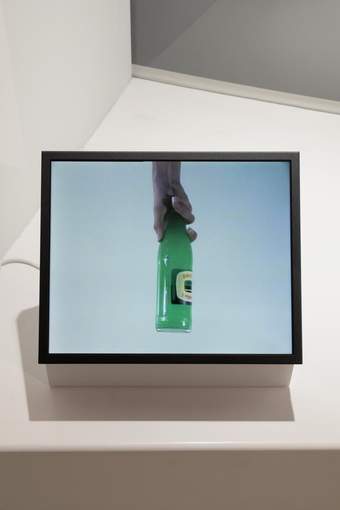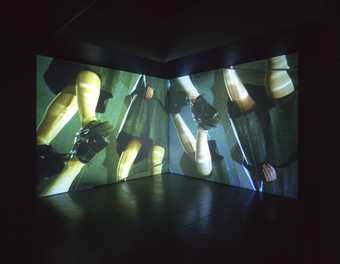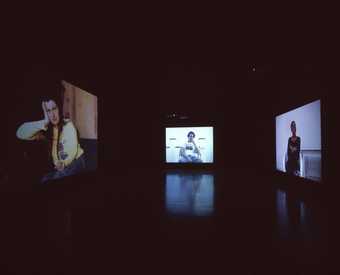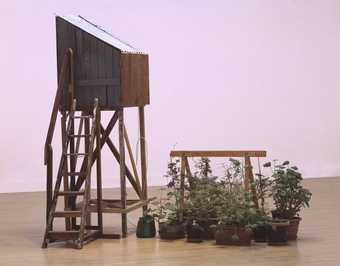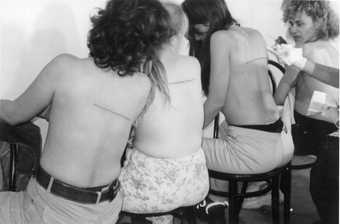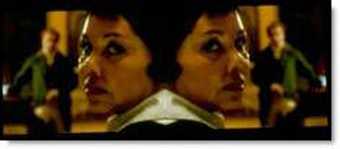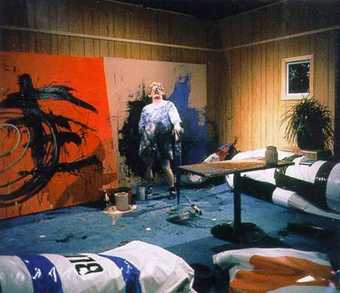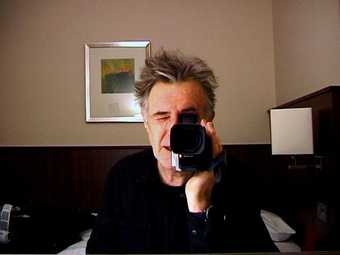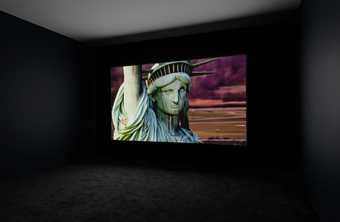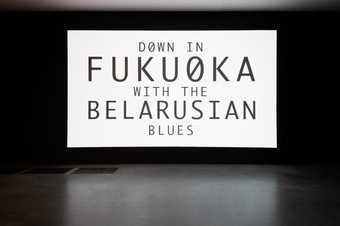
Not on display
- Artists
-
Iain Forsyth born 1973
Jane Pollard born 1972 - Medium
- Video, monitor or flat screen, black and white, and sound (mono)
- Dimensions
- 30min
- Collection
- Tate
- Acquisition
- Purchased 2007
- Reference
- T12455
Summary
Anyone Else Isn’t You 2005 is a black and white video created by the British artists Iain Forsyth and Jane Pollard and lasting approximately thirty minutes. Over the course of the video’s duration a total of fourteen people talk on camera about the importance of music in their romantic relationships. The subjects are shown from the front and close up so that their heads and shoulders are the only parts of them visible, and the video footage moves back and forth between the fourteen different subjects, such that their narratives become intertwined with one another. The statements that they deliver, which range from joyous to heartbreaking in tone and content, are intimate in nature and are presented in candid language. The emotional tension in the work is increased by the way in which the video cuts between different subjects, often interspersing deeply contrasting types of story and psychological response.
Forsyth and Pollard filmed Anyone Else Isn’t You in hobbypopMUSEUM in Düsseldorf in 2001 and the final work was created in 2005 for an exhibition held that year at The Hospital, a private members’ club in London. When filming the footage, Forsyth and Pollard stood behind the camera asking questions (which were subsequently edited out of the final film), the first of which was concerned with musical mix-tapes they had made or received during their lives. The subjects’ responses were then used as prompts for further discussion about their musical interests and their connection to relationships that they had experienced.
The title of the work, Anyone Else Isn’t You, is taken from a song of the same name released in 1990 by the British indie rock band The Field Mice, the lyrics of which relate to heartbreak, loneliness and the worry that ‘I cannot picture myself ever/Ever being happy again’. By naming the video after this song, Forsyth and Pollard highlight the romantic anguish that is connected with certain types of music, in this case indie rock, a genre that the participants cite frequently when discussing their emotional experiences in the video.
Anyone Else Isn’t You refers somewhat nostalgically to the practice common in the 1980s and early 1990s of making a carefully crafted mix-tape as a means of expressing feeling at the beginning of a romantic relationship, as well as to the more recent and much more publicly available video diary broadcast on television or the internet. Through its exploration of both of these formats, the film could be seen to address the ways in which the division between the personal and the public realms has become increasingly blurred in the digital age. Discussing Anyone Else Isn’t You in 2005, the art critic J.J. Charlesworth observed that
Both the mix-tape and the personalised, confessional documentary are forms of culture we’ve become used to, and we feel comfortable with the idea of hearing people like us reminiscing about something we’ve probably done ourselves … perhaps Anyone Else tells us two things; about how a broadcast and serially produced culture has come to present us with the image of our own personal, private lives; and how the mix-tape is a different form, in which the individual takes back a small space out of that culture, for themselves and for someone else.
(Charlesworth 2005, accessed 24 December 2014.)
In this sense, the film could be considered a reflection on what it means to connect and communicate with those around us in an authentic way, as well as an exploration of the contemporary tendency towards voyeurism and over-sharing.
Forsyth and Pollard met in 1992 while studying fine art and art theory at Goldsmiths College in London, and have worked collaboratively since. They became known in the late 1990s for their live performance works that involved re-enacting significant moments from the history of rock music. Anyone Else Isn’t You is one of a series of four short video-diary-style films made by Forsyth and Pollard in 2001–7, collectively titled Precious Little, that take as their subject the connection between mix-tapes and romantic experience. The themes of love, emotion, musical history and rock culture recur in several of Forsyth and Pollard’s other works, including 20,000 Days on Earth (2014, on general release), a feature-length film that presents a semi-fictional account of twenty-four hours in the life of the Australian singer and songwriter Nick Cave.
Further reading
This Much is Certain, exhibition catalogue, Royal College of Art, London 2004, p.83.
J.J. Charlesworth, ‘Anonymous Lovers: The Personal and the Private in Anyone Else Isn’t You’, in Anyone Else Isn’t You, exhibition catalogue, The Hospital, London 2005, http://www.iainandjane.com/press/anonymouslovers/index.shtml, accessed 24 December 2014.
Live!: L’Arte Incontra il Rock, exhibition catalogue, Centro per l’Arte Contemporanea Luigi Pecci, Milan 2011.
Michal Goldschmidt
December 2014
Supported by Christie’s.
Does this text contain inaccurate information or language that you feel we should improve or change? We would like to hear from you.
Film and audio
Explore
- emotions, concepts and ideas(16,416)
-
- formal qualities(12,454)
-
- photographic(4,673)
- head / face(2,497)
You might like
-
Bill Viola Four Hands
2001 -
Roderick Buchanan Sodastream
1997 -
Jane and Louise Wilson Gamma
1999 -
Sam Taylor-Johnson OBE Killing Time
1994 -
Tracey Emin The Perfect Place to Grow
2001 -
Sir Isaac Julien CBE RA Vagabondia
2000 -
Susan Hiller Psi Girls
1999 -
Christina Mackie Irrig
2005 -
Paul McCarthy Painter
1995 -
Nigel Cooke New Accursed Art Club
2007 -
Rabih Mroué On Three Posters
2004 -
John Smith Hotel Diaries
2001–7 -
Sir Steve McQueen Static
2009 -
Young-Hae Chang Heavy Industries (Young-Hae Chang, Marc Voge) TRAILER
2010


